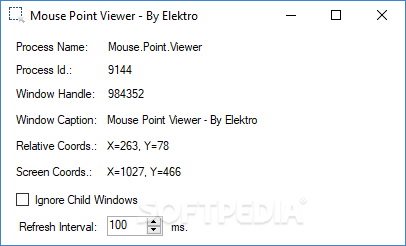


PROCESSING MOUSE COORDINATES HOW TO
This chapter shows how to evaluate and process mouse events, mouse data, and contextual information. Processing the Mouse Interface (Application Development)Ĭhapter 47. mouseWheelEvent( x, y, modifiers, xDelta, yDelta). mouseWheel( x, y, modifiers, xDelta, yDelta). mouseUpEvent( x, y, modifiers, buttonNumber). mouseMoveEvent( x, y, modifiers, buttons). mouseDownEvent( x, y, modifiers, buttonNumber, clickCount). manageMethodConnection( oldAction, newAction, signal, method, sync: false). manageFunctionConnection( oldAction, newAction, signal, sync: false). keyUpEvent( char, modifiers, unicode, keycode, key, spontaneous). keyDownEvent( char, modifiers, unicode, keycode, key, spontaneous). A view must be enabled for the mouse actions to work.įrom extension in /usr/local/share/SuperCollider/SCClassLibrary/Common/GUI/Base/viewExtensionsQt.sc. Use the methods below to set or get the view's actions in response to mouse interaction with the view. However, returning either true or false will completely bypass the view's C++ implementation, so it will not get a chance at responding to the event with its standard behavior. True means you have responded to the event, and the propagation will be stopped false means you are not interested in the event, and the event will propagate. If you wish to control whether the event will be propagated or not, return true or false from the action. Event processing works differently: by default, after a mouse or key action is evaluated, the control returns to the C++ implementation of the view, and if no response to the particular mouse or key event is implemented there, it propagates to the parent. Key and mouse event processingīoth mouse and key events can propagate to the parent view. \globalKeyDownAction or \mouseUpAction or \onClose, etc.). In other words, 'add' method will be invoked on that variable by default that is \action, but any other (sensible) instance or class variable of the view could work (e.g. selectorĪ Symbol containing the name of the action variable to which 'func' will be added. Arguments: funcĪny object to add as an action, usually a Function. This is useful for adding functionality to existing frameworks that have action functions already.
PROCESSING MOUSE COORDINATES PLUS
If 'selector' is not an Array or a List, it will become one, containing the previous object plus 'func'. Arguments: pĪdds/removes 'func' to or from the list of objects in the variable determined by 'selector'.

See QPalette for detailed explanation of how palettes work. Therefore, if you wish to change the view's palette, you have to set the changed palette back on the view: w = Window().front.layout_( HLayout( a = Slider() ) ) Ī.palette = a.palette.buttonText_( if(a.value > 0.5) ) When getting a palette, it will return a new copy of the view's palette every time. When setting a palette, only those colors that have been set on the palette will take effect, other colors will be inherited from the parent view's palette. Get or set the palette to be used by the view. this is safe even if window is still open because Background object holds the Image monte carlo :) exec every line to test ~window = Window.new("Image background") ~image = Image.new(SCDoc.helpSourceDir +/+ "images/Swamp.png") 0 <= alpha <= 1, and values outside of that range will be clipped fromRect 1 fixed to left, fixed to top 2 horizontally tile, fixed to top 3 fixed to right, fixed to top 4 fixed to left, vertically tile 5 horizontally tile, vertically tile 6 fixed to right, vertically tile 7 fixed to left, fixed to bottom 8 horizontally tile, fixed to bottom 9 fixed to right, fixed to bottom 10 fit 11 center, center (scale) 12 center, fixed to top 13 center, fixed to bottom 14 fixed to left, center 15 fixed to right, center 16 center, center (no scale) alpha By default 1 (fixed to left, fixed to top). Sets an Image as a valid view background, with 16 different drawing modes and opacity support.


 0 kommentar(er)
0 kommentar(er)
